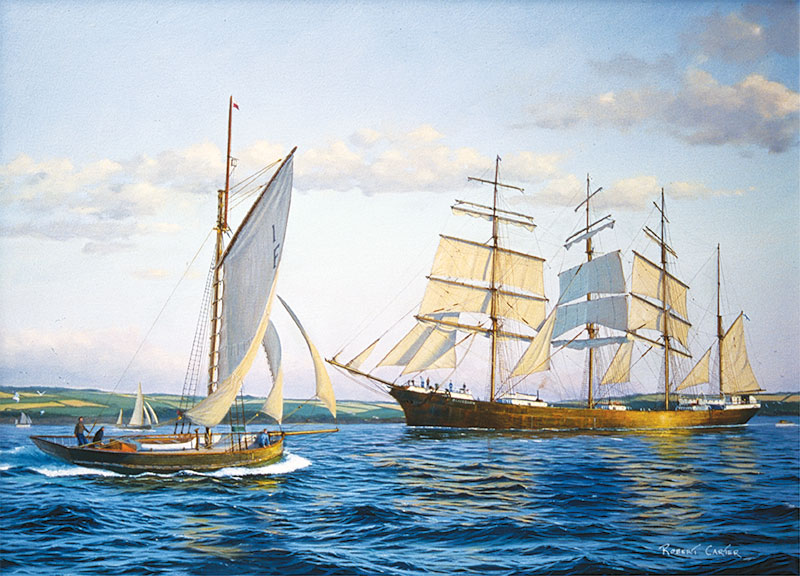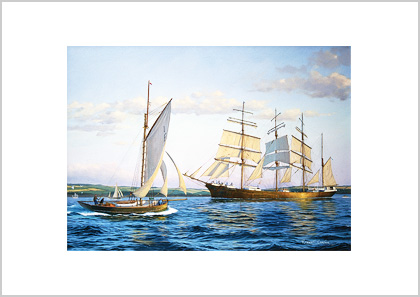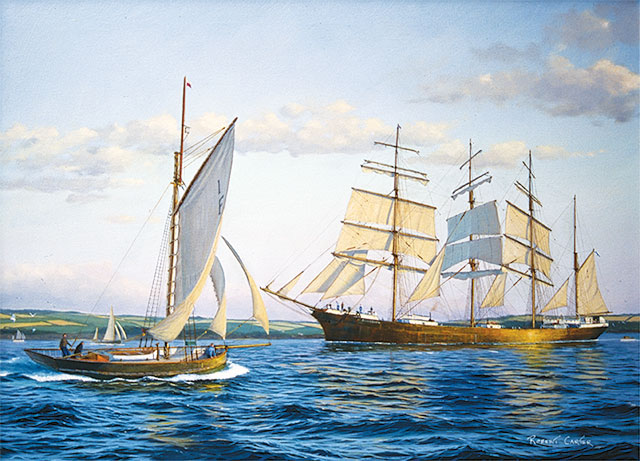
A sunny afternoon at Carrick Roads, the entrance to Falmouth Harbour, and Gustaf Erikson’s 4-masted barque Olivebank, deep laden with Australian grain, heaves to, after a voyage from Port Victoria, South Australia.
She called at Falmouth five times for her Orders in the 1930’s. The pilot cutter in the foreground is typical of the type of craft that was used before engine-driven vessels replaced them.
Several craft in the distance are significant. They are Falmouth Quay Punts; usually cutter or yawl rigged, they were a feature of this Port. They derived a living from the ocean-going ships that called in for their orders. Their stumpy masts allowed them to sail alongside a large sailer, without their becoming entangled in the lower yards. They purveyed fresh vegetables, fruit, meat, fish, tobacco and newspapers to the crews, who had subsisted on sailing ship fare for the previous three or four months.
Olivebank continued in trade until 1939. Sailing from Port Victoria on 20 March she discharged her grain cargo at Barry Dock, sailing for Mariehamn on 29 August just prior to the second world war breaking out.
On 8 September, she ran through a North Sea minefield and struck a mine, sinking rapidly. The North Sea in the area is comparatively shallow and she settled on the bottom with her upper masts above water. Captain Granith and six of her crew went down with the ship. The remaining fourteen of her crew survived by clinging to her masts and were picked up by a Danish fishing boat several days later.
PRINT DETAILS – Regular size print

Fine quality giclée print on Chromajet Spectrum 225 gsm satin paper.
Print care
Although the inks used for these giclée prints is guaranteed to last 90 years under normal circumstances, their life will be reduced if hung in direct sunlight or strong ultraviolet light. They are intended to be framed under UV inhibiting glass, using acid free mounting materials. Non-reflecting glass is also recommended.
Print care
Although the inks used for these giclée prints is guaranteed to last 90 years under normal circumstances, their life will be reduced if hung in direct sunlight or strong ultraviolet light. They are intended to be framed under UV inhibiting glass, using acid free mounting materials. Non-reflecting glass is also recommended.
Overall: 29.7 x 42 (cm) / 11.7 x 16.5 (in)
Image size: 20.5 x 28.5 (cm) / 8.1 x 11.2 (in)
Shipping locations: We ship to Australia, New Zealand, Europe and the USA for orders via the shopping cart. For other destinations please contact us for a shipping quote.
$85 AUD (includes shipping)
Questions? Please don't hesitate to contact us.

A sunny afternoon at Carrick Roads, the entrance to Falmouth Harbour, and Gustaf Erikson’s 4-masted barque Olivebank, deep laden with Australian grain, heaves to, after a voyage from Port Victoria, South Australia.
Read more
She called at Falmouth five times for her Orders in the 1930’s. The pilot cutter in the foreground is typical of the type of craft that was used before engine-driven vessels replaced them.
Several craft in the distance are significant. They are Falmouth Quay Punts; usually cutter or yawl rigged, they were a feature of this Port. They derived a living from the ocean-going ships that called in for their orders. Their stumpy masts allowed them to sail alongside a large sailer, without their becoming entangled in the lower yards. They purveyed fresh vegetables, fruit, meat, fish, tobacco and newspapers to the crews, who had subsisted on sailing ship fare for the previous three or four months.
Olivebank continued in trade until 1939. Sailing from Port Victoria on 20 March she discharged her grain cargo at Barry Dock, sailing for Mariehamn on 29 August just prior to the second world war breaking out.
On 8 September, she ran through a North Sea minefield and struck a mine, sinking rapidly. The North Sea in the area is comparatively shallow and she settled on the bottom with her upper masts above water. Captain Granith and six of her crew went down with the ship. The remaining fourteen of her crew survived by clinging to her masts and were picked up by a Danish fishing boat several days later.
PRINT DETAILS – Regular size print

Fine quality giclée print on Chromajet Spectrum 225 gsm satin paper.
Print care
Although the inks used for these giclée prints is guaranteed to last 90 years under normal circumstances, their life will be reduced if hung in direct sunlight or strong ultraviolet light. They are intended to be framed under UV inhibiting glass, using acid free mounting materials. Non-reflecting glass is also recommended.
Overall: 29.7 x 42 (cm) / 11.7 x 16.5 (in)
Image size: 20.5 x 28.5 (cm) / 8.1 x 11.2 (in)
Shipping locations: We ship to Australia, New Zealand, Europe and the USA for orders via the shopping cart. For other destinations please contact us for a shipping quote.
$85 AUD (includes shipping)
Questions? Please don't hesitate to contact us.
